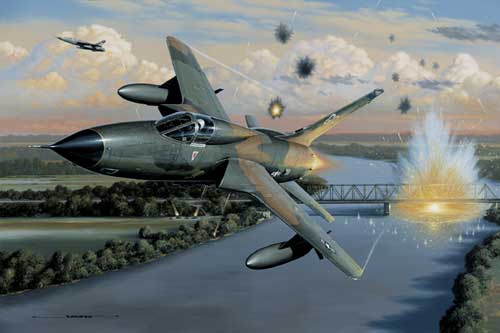  
The Republic F-105 Thunderchief, or “Thud,” as it was nicknamed by many of the pilots who flew it, was conceived as a supersonic, low altitude fighter-bomber capable of carrying a nuclear weapon in its internal bomb bay and two more on its wing stations. The F-105 evolved from a proposal made by Republic to the USAF in 1952. A series of delays, cancellations, spec changes, and other problems resulted in a very long gestation period for this aircraft, with initial production models not reaching operational units until 1958. The Thud was a big, powerful aircraft. With a length of 65 feet and a height of 20 feet, the F-105 would typically fly combat missions with a gross weight at takeoff in excess of 50,000 pounds. Although the F-105 was fortunately never utilized for the nuclear mission it was designed for, it did become the primary tactical bomber utilized by the USAF during the Vietnam War. In fact, the Thud flew more than 75% of all the bombing sorties directed at North Vietnam during the War. The Ham Rong Bridge in North Vietnam was a frequent target for F-105s. Ham Rong translates into English as “Dragon’s Jaws,” and this very important north-south rail and highway line was a vital supply link in allowing the North Vietnamese to send streams of men and materials south. The Ham Rong Bridge was 546 feet long and was 56 feet wide. It took eight years to build this incredibly sturdy bridge and Ho Chi Minh himself dedicated the bridge in 1964. SAMs and antiaircraft batteries heavily defended it. Living up to its name, the bridge was one of the most punishing targets to attack, and many American aircraft and pilots were lost during the numerous attacks on the Dragon’s Jaws. From 1965 to 1968 almost seven hundred aircraft had attacked the bridge, hitting it with more than 10,000 tons of high explosives. Despite these attacks, repair crews worked around the clock, and the bridge remained usable. Rockets proved ineffective and only direct hits with large bombs were likely to do any serious damage. Recognizing this, the North Vietnamese knew that American fighter-bombers would have to pass directly over the Dragon’s Jaws to release their bombs. A wall of antiaircraft fire would be directed directly over the bridge during such attacks, and a horrific toll was exacted on attacking American aircraft. In Stan Stokes’ painting an F-105 piloted by Fred V. Cherry is depicted during an attack on the Ham Rong Bridge. Col. Cherry was shot down in October of 1965 and remained a POW until 1973. He retired from the Air Force in 1981. The Dragon’s Jaw stood as a symbol of North Vietnamese resistance until it was finally destroyed by a laser-guided, smart bomb in1972.
Giclee Eddition Size 100
|